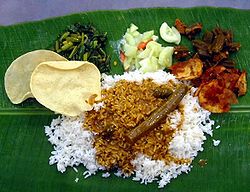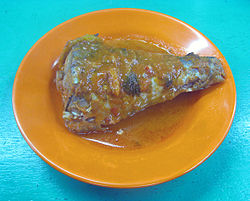Bak-kut-teh (also spelt
bah-kut-teh;
Chinese:
肉骨茶;
Pe̍h-ōe-jī: bah-kut-tê) is a
Chinese soup popularly served in
Malaysia,
Singapore,(where there is a predominant
Hoklo and
Teochew community) and also, neighbouring areas like
Riau Islands and
Southern Thailand.
The name literally translates as "meat bone tea", and at its simplest, consists of meaty
pork ribs simmered in a complex
broth of herbs and spices (including
star anise,
cinnamon,
cloves,
dang gui,
fennel seeds and
garlic) for hours.
[1] Despite its name, there is in fact no tea in the dish itself; the name refers to a strong
oolong Chinese tea
which is usually served alongside the soup in the belief that it
dilutes or dissolves the copious amount of fat consumed in this
pork-laden dish.
However, additional ingredients may include
offal, varieties of mushroom,
choy sum, and pieces of dried
tofu or fried tofu puffs. Additional Chinese herbs may include
yu zhu (玉竹, rhizome of
Solomon's Seal) and
ju zhi
(buckthorn fruit), which give the soup a sweeter, slightly stronger
flavor. Light and dark soy sauce are also added to the soup during
cooking, with varying amounts depending on the variant - the
Teochews version is lighter than the
Hokkiens'. The dish can be garnished with chopped coriander or green onions and a sprinkling of fried shallots.

A meal of
bak kut teh served with Chinese donuts.
Bak kut teh is usually eaten with rice or noodles (sometimes as a noodle soup), and often served with
youtiao / cha kueh [yau char kwai] (strips of
fried dough) for dipping into the soup.
Soy sauce (usually light soy sauce, but dark soy sauce is also offered sometimes) is preferred as a condiment, with which chopped
chilli padi and minced garlic is taken together.
Bak kut teh is typically a famous morning meal. The
Hokkien and
Teochew are traditionally tea-drinking cultures and this aspect runs deep in their cuisines.
 RSS Feed
RSS Feed Twitter
Twitter




 10:12
10:12
 Unknown
Unknown




